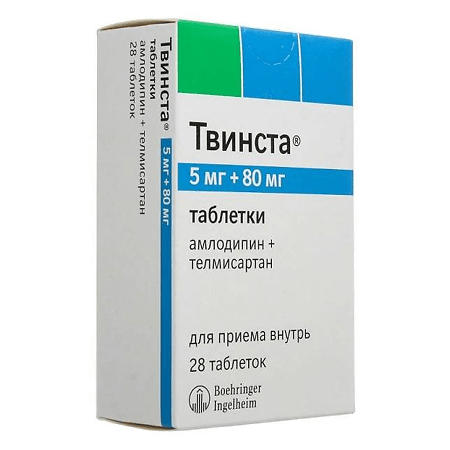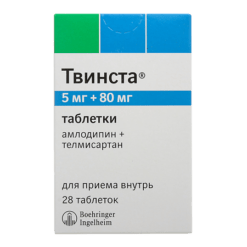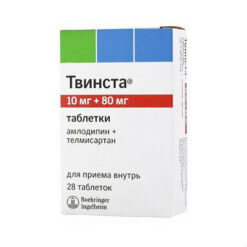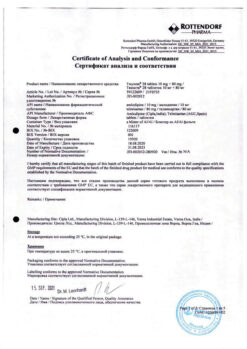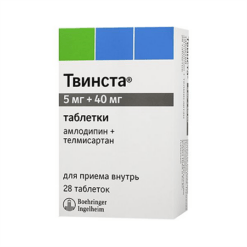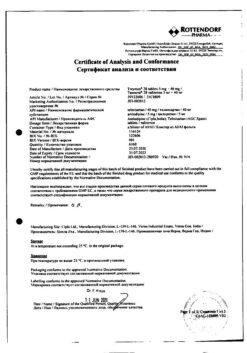No products in the cart.
Twinsta, tablets 5 mg+80 mg 28 pcs
€1.00
Out of stock
(E-mail when Stock is available)
SKU: 511433
Categories: Cardiovascular, High pressure, Medicine
Description
combined hypotensive agent (slow calcium channel blocker + angiotensin II receptor antagonist) ATX code: C09DB04 Pharmacological properties Pharmacodynamics
Twinsta is a combination drug containing two hypotensive agents with complementary actions to control blood pressure in patients with arterial (essential) hypertension: The angiotensin II receptor antagonist (ARA II), telmisartan, and the “slow” calcium channel blocker (CMCB) dihydropyridine derivative, amlodipine.
The combination of these agents has additive hypotensive effects, lowering blood pressure to a greater extent than each individual component.
The drug Twinsta, taken once daily, results in an effective and sustained decrease in blood pressure within 24 hours.
Telmisartan
Telmisartan is a specific ARA II (type AT 1) that is effective when taken orally. It has high affinity for the AT 1 subtype of angiotensin II receptors, through which angiotensin II action is realized. It displaces angiotensin II from binding to the receptor, having no agonist effect against this receptor. Telmisartan binds only to the AT 1 subtype of angiotensin II receptor. The binding is long-lasting. It has no affinity for other receptors, including AT 2 receptor. Reduces blood aldosterone concentration, does not inhibit plasma renin and does not block ion channels. Telmisartan does not inhibit angiotensin-converting enzyme (kinininase II, an enzyme that also degrades bradykinin). Therefore, an increase in bradykinin-induced adverse effects is not expected.
In patients, telmisartan at a dose of 80 mg completely blocks the hypertensive effects of angiotensin II. The onset of hypotensive action is noted within 3 hours after the first telmisartan administration. The action of the drug persists for 24 hours and remains significant up to 48 hours. A pronounced hypotensive effect usually develops 4-8 weeks after regular use.
In patients with arterial hypertension, telmisartan reduces systolic and diastolic blood pressure (BP) without affecting heart rate (HR).
In case of abrupt telmisartan withdrawal, BP gradually returns to baseline levels without development of “withdrawal” syndrome.
The incidence of dry cough was significantly lower in patients receiving telmisartan compared with the use of angiotensin-converting enzyme inhibitors (ACEs).
Two large randomized controlled trials, ONTARGET (Global Endpoints in Telmisartan Monotherapy and Ramipril) and VA NEPHRON-D (The Veterans Affairs Nephropathy in Diabetes Study, conducted by the US Department of Veterans Affairs), examined the use of a combination ACE inhibitor in combination with an angiotensin II receptor antagonist. The ONTARGET study was a study conducted in patients with a history of cardiovascular or cerebrovascular disease or type 2 diabetes with confirmed target organ damage. The VA NEPHRON-D study was a study in patients with type 2 diabetes and diabetic nephropathy.
These studies showed no significant beneficial effects on renal and/or cardiovascular outcomes and mortality, whereas an increased risk of hyperkalemia, acute renal failure and/or arterial hypotension was observed compared to monotherapy. Given similar pharmacodynamic properties, these results are also relevant for other ACE inhibitors and angiotensin II receptor antagonists.
Therefore, ACE inhibitors and angiotensin II receptor antagonists should not be used together in patients with diabetic nephropathy.
The ALTITUDE (Aliskiren Use in Patients with Type 2 Diabetes with Assessment of Cardiovascular and Renal Endpoints) was a study designed to test the benefit of adding aliskiren to standard treatment with an ACE inhibitor or angiotensin II receptor antagonist in patients with type 2 diabetes and chronic kidney disease, cardiovascular disease or both. The study was terminated early due to an increased risk of adverse outcomes. Cardiovascular death and stroke were more frequently reported in the aliskiren group than in the placebo group, and adverse events and serious adverse events (hyperkalemia, arterial hypotension, and impaired renal function) were more frequently reported in the aliskiren group than in the placebo group.
There was a difference in plasma concentrations of telmisartan in men and women. Cmax and AUC were approximately 3 and 2 times higher in women compared to men, respectively, with no significant effect on efficacy.
Amlodipine
Amlodipine is a dihydropyridine derivative and belongs to the BMCC class. It inhibits transmembrane entry of calcium ions into cardiomyocytes and vascular smooth muscle cells.
The mechanism of hypotensive action of amlodipine is associated with a direct relaxant effect on vascular smooth muscle cells, resulting in reduction of peripheral vascular resistance and BP decrease.
In patients with arterial hypertension, use of amlodipine once daily provides clinically significant BP reduction for 24 hours. Orthostatic arterial hypotension is not common during the use of amlodipine due to the slow onset of action of the drug.
In patients with arterial hypertension and normal renal function, amlodipine at therapeutic doses resulted in decreased renal vascular resistance and increased glomerular filtration rate and effective renal plasma blood flow without changes in filtration or proteinuria.
Amlodipine does not cause any metabolic adverse effects or changes in plasma lipid concentrations and is therefore suitable for use in patients with bronchial asthma, diabetes and gout.
The use of amlodipine in patients with heart failure is not associated with negative inotropic effects (does not decrease exercise tolerance and left ventricular ejection fraction).
Pharmacokinetics
Pharmacokinetics of fixed-dose combination
The rate and degree of absorption of Twinsta are equivalent to the bioavailability of telmisartan and amlodipine when used as separate tablets.
Pharmacokinetics of individual components:
Telmisartan
Absorption
When taken orally, it is rapidly absorbed from the gastrointestinal tract. Absolute bioavailability of telmisartan is about 50%. When taken concomitantly with food, the decrease in area under the curve “concentration-time” (AUC) ranges from 6% (at a dose of 40 mg) to 19% (at a dose of 160 mg). Three hours after oral administration, plasma concentrations become similar to those of telmisartan on an empty stomach.
Distribution
Binding to plasma proteins > 99.5%, mainly to albumin and alpha-1 glycoprotein. Average apparent volume of distribution at equilibrium concentration is 500L.
Metabolism
Telmisartan is metabolized by conjugation with glucuronic acid. Metabolites are pharmacologically inactive.
Elimation
The elimination half-life (T V) is more than 20 hours. Maximum plasma concentration (Cmax) and, to a lesser extent, AUC increase disproportionately to the dose. There are no data on clinically significant accumulation of telmisartan, when used in recommended doses.
Extracted through the intestine unchanged, excretion by the kidneys is less than 1%. Total plasma clearance is high (approximately 1000 ml/min) compared to “hepatic” blood flow (about 1500 ml/min).
Amlodipine
Absorption
After oral administration of amlodipine at therapeutic doses the maximum plasma concentrations are reached after 6-12 hours. The absolute bioavailability ranges from 64% to 80%. Food intake does not affect the bioavailability of amlodipine.
Distribution
The volume of distribution of amlodipine is approximately 21 l/kg. In in vitro studies it has been shown that in patients with arterial hypertension approximately 97.5% of circulating amlodipine is bound to plasma proteins.
Metabolism
Amlodipine is largely (approximately 90%) metabolized in the liver to form inactive metabolites.
Elimation
Blood plasma excretion of amlodipine is biphasic with a TA of approximately 30-50 hours. Stable concentration in blood plasma is reached after continuous drug administration for 7-8 days. Amlodipine is excreted by the kidneys both unchanged (10%) and as metabolites (60%).
Pharmacokinetics in special clinical cases:
In elderly patients
The pharmacokinetics of telmisartan in elderly patients does not differ from younger patients. Amlodipine clearance tends to decrease in elderly patients, resulting in increased AUC and TA.
Patients with renal impairment
Telmisartan is bound to plasma proteins and is not eliminated by hemodialysis in patients with renal impairment. In patients with renal impairment, plasma concentrations of telmisartan are doubled. However, telmisartan concentrations are lower in patients on hemodialysis and the T1/2 is unchanged. Pharmacokinetics of amlodipine in patients with impaired renal function is not significantly changed.
Patients with hepatic impairment
Pharmacokinetics studies performed in patients with hepatic impairment have shown that the absolute bioavailability of telmisartan is increased to almost 100%. TA in patients with hepatic impairment does not change. In patients with hepatic impairment, the clearance of amlodipine was decreased, resulting in an increase in AUC of approximately 40-60%.
Indications
Indications
Arterial hypertension (for patients whose blood pressure is not sufficiently controlled by telmisartan or amlodipine in monotherapy).
Arterial hypertension (for patients for whom combination therapy is indicated).
Patients with arterial hypertension receiving telmisartan and amlodipine in the form of separate tablets as a replacement for this therapy.
Pharmacological effect
Pharmacological effect
combined antihypertensive drug (slow calcium channel blocker + angiotensin II receptor antagonist)
ATX code:
C09DB04
Pharmacological properties
Pharmacodynamics
Twynsta is a combination drug containing two antihypertensive substances with complementary effects that help control blood pressure in patients with arterial (essential) hypertension: an angiotensin II receptor antagonist (ARA II), telmisartan, and a slow calcium channel blocker (SCBC), a dihydropyridine derivative, amlodipine.
The combination of these substances has an additive hypotensive effect, reducing blood pressure to a greater extent than each individual component.
Twynsta, taken once daily, leads to an effective and sustained reduction in blood pressure over 24 hours.
Telmisartan
Telmisartan is a specific ARA II (type AT 1), effective when taken orally. It has a high affinity for the AT 1 subtype of angiotensin II receptors, through which the action of angiotensin II is realized. Displaces angiotensin II from its connection with the receptor, without having an agonist effect on this receptor. Telmisartan binds only to the AT 1 subtype of angiotensin II receptors. The connection is long-term. It has no affinity for other receptors, including the AT 2 receptor. Reduces the concentration of aldosterone in the blood, does not inhibit renin in the blood plasma and does not block ion channels. Telmisartan does not inhibit angiotensin-converting enzyme (kininase II – an enzyme that also destroys bradykinin). Therefore, an increase in the undesirable effects caused by bradykinin is not expected.
In patients, telmisartan at a dose of 80 mg completely blocks the hypertensive effect of angiotensin II. The onset of the hypotensive effect is observed within 3 hours after the first dose of telmisartan. The effect of the drug lasts for 24 hours and remains significant for up to 48 hours. A pronounced hypotensive effect usually develops 4-8 weeks after regular use.
In patients with arterial hypertension, telmisartan reduces systolic and diastolic blood pressure (BP) without affecting heart rate (HR).
In case of abrupt withdrawal of telmisartan, blood pressure gradually returns to the initial level without the development of withdrawal syndrome.
The incidence of dry cough was significantly lower in patients receiving telmisartan compared with angiotensin-converting enzyme (ACE) inhibitors.
Two large randomized controlled trials, ONTARGET (Telmisartan Alone and in Combination with Ramipril Global Endpoint Study) and VA NEPHRON-D (The Veterans Affairs Nephropathy in Diabetes Study), examined the use of a combination of an ACE inhibitor in combination with an angiotensin II receptor antagonist. The ONTARGET study was a study conducted in patients with a history of cardiovascular or cerebrovascular disease or type 2 diabetes mellitus with evidence of end-organ damage. The VA NEPHRON-D study was a study in patients with type 2 diabetes mellitus and diabetic nephropathy.
These studies did not show significant beneficial effects on renal and/or cardiovascular outcomes and mortality, whereas an increased risk of hyperkalemia, acute renal failure and/or hypotension was observed compared with monotherapy. Given the similar pharmacodynamic properties, these results are also relevant for other ACE inhibitors and angiotensin II receptor antagonists.
Therefore, ACE inhibitors and angiotensin II receptor antagonists should not be used together in patients with diabetic nephropathy.
The ALTITUDE (Aliskiren Study in Patients with Type 2 Diabetes with Cardiovascular and Renal Endpoints) was a study designed to test the benefit of adding aliskiren to standard treatment with an ACE inhibitor or angiotensin II receptor antagonist in patients with type 2 diabetes and chronic kidney disease, cardiovascular disease, or both. The study was stopped early due to an increased risk of adverse outcomes. Cardiovascular death and stroke were reported more frequently in the aliskiren group than in the placebo group, and adverse events and serious adverse events (hyperkalemia, hypotension, and renal dysfunction) were reported more frequently in the aliskiren group than in the placebo group.
There is a difference in plasma concentrations of telmisartan in men and women. Cmax and AUC were approximately 3-fold and 2-fold, respectively, higher in women compared to men, with no significant effect on efficacy.
Amlodipine
Amlodipine is a dihydropyridine derivative and belongs to the BMCC class. It inhibits the transmembrane entry of calcium ions into cardiomyocytes and vascular smooth muscle cells.
The mechanism of the hypotensive effect of amlodipine is associated with a direct relaxing effect on vascular smooth muscle cells, which leads to a decrease in peripheral vascular resistance and a decrease in blood pressure.
In patients with arterial hypertension, the use of amlodipine once a day provides a clinically significant reduction in blood pressure over 24 hours. Orthostatic hypotension is not common during the use of amlodipine due to the slow onset of action of the drug.
In patients with arterial hypertension and normal renal function, amlodipine at therapeutic doses led to a decrease in renal vascular resistance, an increase in glomerular filtration rate and effective plasma blood flow in the kidneys without changing filtration or proteinuria.
Amlodipine does not cause any metabolic adverse effects or changes in plasma lipid concentrations and is therefore suitable for use in patients with asthma, diabetes mellitus and gout.
The use of amlodipine in patients with heart failure is not accompanied by a negative inotropic effect (exercise tolerance is not reduced, and the left ventricular ejection fraction is not reduced).
Pharmacokinetics
Pharmacokinetics of fixed dose combinations
The rate and extent of absorption of Twynsta are equivalent to the bioavailability of telmisartan and amlodipine when administered as separate tablets.
Pharmacokinetics of individual components:
Telmisartan
Suction
When taken orally, it is quickly absorbed from the gastrointestinal tract. The absolute bioavailability of telmisartan is about 50%. When taken simultaneously with food, the reduction in the area under the concentration-time curve (AUC) ranges from 6% (at a dose of 40 mg) to 19% (at a dose of 160 mg). 3 hours after oral administration, the concentration in the blood plasma becomes similar to the concentration when taking telmisartan on an empty stomach.
Distribution
Plasma protein binding > 99.5%, mainly with albumin and alpha-1 glycoprotein. The average apparent volume of distribution at equilibrium concentration is 500 l.
Metabolism
Telmisartan is metabolized by conjugation with glucuronic acid. Metabolites are pharmacologically inactive.
Removal
The half-life (T V) is more than 20 hours. The maximum plasma concentration (Cmax) and, to a lesser extent, AUC increase disproportionately with the dose. There is no data on clinically significant accumulation of telmisartan when used in recommended doses.
Excreted through the intestines unchanged, excretion by the kidneys is less than 1%. The total plasma clearance is high (approximately 1000 ml/min) compared to the hepatic blood flow (approximately 1500 ml/min).
Amlodipine
Suction
After taking amlodipine orally in therapeutic doses, maximum plasma concentrations are achieved within 6-12 hours. The absolute bioavailability ranges from 64% to 80%. Food intake does not affect the bioavailability of amlodipine.
Distribution
The volume of distribution of amlodipine is approximately 21 L/kg. In vitro studies have shown that in patients with arterial hypertension, approximately 97.5% of circulating amlodipine is bound to plasma proteins.
Metabolism
Amlodipine is largely (approximately 90%) metabolized in the liver to form inactive metabolites.
Removal
The elimination of amlodipine from blood plasma occurs in two phases, TA is approximately 30-50 hours. Stable plasma concentrations are achieved after continuous administration of the drug for 7-8 days. Amlodipine is excreted by the kidneys both unchanged (10%) and in the form of metabolites (60%).
Pharmacokinetics in special clinical cases:
In elderly patients
The pharmacokinetics of telmisartan in elderly patients does not differ from young patients. In elderly patients, there is a tendency to decrease the clearance of amlodipine, which leads to an increase in AUC and TA.
Patients with renal failure
Telmisartan binds to plasma proteins and is not removed by hemodialysis in patients with renal failure. In patients with renal failure, the plasma concentration of telmisartan doubles. However, in patients on hemodialysis, lower concentrations of telmisartan are observed, T1/2 does not change. The pharmacokinetics of amlodipine in patients with impaired renal function does not change significantly.
Patients with liver failure
Pharmacokinetic studies conducted in patients with impaired liver function showed that the absolute bioavailability of telmisartan increases to almost 100%. TA in patients with impaired liver function does not change. In patients with hepatic impairment, the clearance of amlodipine was reduced, resulting in an increase in AUC by approximately 40-60%.
Special instructions
Special instructions
Pregnancy
Angiotensin II receptor antagonists should not be started during pregnancy. Unless continued treatment is considered necessary, in patients planning pregnancy, these drugs should be replaced with alternative antihypertensive drugs that have an established safety profile for use during pregnancy. When pregnancy is diagnosed, treatment with angiotensin II receptor antagonists should be stopped immediately and, if necessary, alternative treatment initiated.
Liver failure
Telmisartan is excreted primarily in bile. In patients with biliary obstruction or hepatic impairment, drug clearance is expected to be reduced. In addition, as with all calcium antagonists, the half-life of amlodipine is prolonged in patients with impaired liver function, and dosing recommendations for this drug have not been established. In this regard, the combination of telmisartan/amlodipine should be used with caution in such patients.
Renovascular arterial hypertension
Patients with bilateral renal artery stenosis or arterial stenosis of a single functioning kidney who are taking medications that affect the renin-angiotensin-aldosterone system (RAAS) are at increased risk of developing severe hypotension and renal failure.
Renal dysfunction and conditions after kidney transplantation
There is no experience with the use of Twynsta in patients who have recently undergone kidney transplantation. Amlodipine and telmisartan are not removed by hemodialysis. In patients with impaired renal function, periodic monitoring of serum potassium and creatinine levels is recommended.
Reduced circulating blood volume (CBV) and/or hyponatremia
Due to limited salt intake, intensive diuretic therapy, diarrhea or vomiting, symptomatic arterial hypotension may develop, especially after taking the first dose of the drug. Before using Twynsta, such conditions require correction. If hypotension occurs during use of Twynsta, the patient should be placed in the supine position and, if necessary, intravenous saline should be administered. Treatment can be continued after blood pressure has stabilized.
Dual blockade of the renin-angiotensin-aldosterone system (RAAS)
There is evidence that the simultaneous use of ACE inhibitors, angiotensin II receptor antagonists or aliskiren increases the risk of hypotension, hyperkalemia and decreased renal function (including acute renal failure). Therefore, double blockade of the RAAS by combined use of ACE inhibitors, angiotensin II receptor antagonists or aliskiren is not recommended.
If treatment with dual blockade of the RAAS is considered necessary, it should only be carried out under specialist supervision and subject to careful monitoring of renal function, electrolyte concentrations and blood pressure.
ACE inhibitors and angiotensin II receptor antagonists should not be used concomitantly in patients with diabetic nephropathy.
Other conditions characterized by activation of the RAAS
In cases where vascular tone and renal function depend primarily on the activity of the RAAS (for example, in patients with chronic heart failure or kidney disease, including renal artery stenosis), the administration of drugs that affect this system may be accompanied by the development of acute arterial hypotension, hyperazotemia, oliguria, and, in rare cases, acute renal failure.
Primary aldosteronism
In patients with primary aldosteronism, antihypertensive drugs whose mechanism of action is to inhibit the RAAS are usually not effective. Thus, the use of telmisartan in such cases is not recommended.
Diabetes mellitus
In patients with diabetes mellitus (DM) with additional cardiovascular risk (ie, concomitant coronary artery disease), the risk of fatal myocardial infarction and sudden cardiovascular death may be increased when treated with antihypertensive agents such as APA II and angiotensin-converting enzyme inhibitors (ACEIs).
Stenosis of the aortic and mitral valves, hypertrophic obstructive cardiomyopathy
In patients with aortic or mitral stenosis, or obstructive hypertrophic cardiomyopathy, the use of Twynsta, as well as other vasodilators, requires special caution.
Unstable angina, acute myocardial infarction
There is no data on the use of Twynsta in patients with unstable angina, in the acute period and within one month after myocardial infarction.
Heart failure
A clinical study found that the use of amlodipine in patients with heart failure of non-ischemic etiology of functional class III and IV according to the NYHA classification was accompanied by a more frequent development of pulmonary edema (despite the absence of a significant difference in the frequency of worsening heart failure compared with placebo).
Patients with diabetes mellitus receiving insulin or other glucose-lowering medications
In these patients, hypoglycemia may occur during treatment with telmisartan. Therefore, appropriate monitoring of blood glucose concentrations should be considered in such patients; You may need to adjust the dose of insulin or glucose-lowering medications if necessary.
Hyperkalemia
During treatment with drugs that affect the RAAS, especially in the presence of impaired renal function and/or heart failure, hyperkalemia may occur. Hyperkalemia may be fatal in elderly patients, in patients with renal impairment, in patients with diabetes mellitus, in patients concomitantly receiving other drugs that may increase serum potassium concentrations, and/or in patients with intercurrent events.
Before considering the possibility of concomitant use of drugs that affect the RAAS, it is necessary to assess the benefit-risk ratio.
The main risk factors for the development of hyperkalemia are:
diabetes mellitus, renal dysfunction, age (> 70 years);
combination with one or more other drugs that affect the RAAS and/or nutritional supplements containing potassium. Drugs or therapeutic classes of drugs that may precipitate hyperkalemia include potassium salts, potassium-sparing diuretics, ACE inhibitors, angiotensin II receptor antagonists, NSAIDs (including selective COX-2 inhibitors), heparin, immunosuppressants (cyclosporine or tacrolimus), and trimethoprim;
intercurrent events, in particular, dehydration, acute cardiac decompensation, metabolic acidosis, deterioration of renal function, sudden deterioration of renal disease (eg, infectious diseases), cell lysis (eg, limb ischemia, rhabdomyolysis, major trauma).
Serum potassium concentrations should be carefully monitored in these patients.
Sorbitol
Each Twynsta tablet contains 168.64 mg of sorbitol.
Other
An excessive decrease in blood pressure in patients with ischemic cardiomyopathy or ischemic cardiovascular disease can lead to myocardial infarction or stroke.
The drug Twynsta is effective in the treatment of patients of the Negroid race (in this population, renin activity in the blood is usually reduced).
Impact on the ability to drive vehicles and machinery
Studies of the effect on the ability to drive vehicles and operate machinery have not been conducted. However, it should be taken into account that during treatment, undesirable reactions such as fainting, drowsiness or dizziness may occur. Therefore, caution should be exercised when operating vehicles or machinery. If patients experience these sensations, they should avoid performing potentially dangerous activities such as driving or operating machinery.
Active ingredient
Active ingredient
Amlodipine, Telmisartan
Composition
Composition
Active ingredients:
amlodipine besilate* 6.935 mg
telmisartan 80,000 mg
*equivalent to 5,000 mg amlodipine
Excipients:
Telmisartan layer: sodium hydroxide 6.720 mg; povidone K25 24,000 mg; meglumine 24,000 mg; sorbitol 337.280 mg; magnesium stearate 8,000 mg;
amlodipine layer: microcrystalline cellulose 125.765 mg; pregelatinized starch 53,000 mg; corn starch 10,000 mg; colloidal silicon dioxide 2,000 mg; magnesium stearate 2,000 mg; dye mixture 0.300 mg**.
** The dye mixture consists of 76% iron oxide black (E172, NF name: iron oxide), 4% iron oxide yellow (E172, NF name: iron oxide) and 20% FD&C blue No. 1 (brilliant blue FCF aluminum varnish) (E133).
Pregnancy
Pregnancy
There have been no special studies of Twynsta during pregnancy and breastfeeding. The effects associated with the individual components of the drug are described below.
Pregnancy
Telmisartan
The use of ARA II is contraindicated during pregnancy. If pregnancy is diagnosed, the drug should be stopped immediately. If necessary, alternative therapy should be prescribed.
Preclinical studies of telmisartan did not reveal teratogenic properties, but established the presence of fetotoxicity.
It is known that the use of ARA II during the second and third trimesters of pregnancy has a fetotoxic effect (decreased renal function, oligohydramnios, delayed ossification of the fetal skull), and neonatal toxicity (renal failure, arterial hypotension and hyperkalemia) is also observed.
In patients planning pregnancy, ARA II should be replaced with other antihypertensive drugs that have an established safety profile for use during pregnancy (unless continued treatment with ARA II is considered necessary).
If ARA II is used during pregnancy, then, starting from the second trimester of pregnancy, ultrasound monitoring of kidney function and the condition of the skull is recommended. Newborns whose mothers received ARA II should be carefully monitored for the development of arterial hypotension.
Amlodipine
The limited data available regarding the effects of amlodipine or other CBMCs do not indicate adverse effects on the fetus. However, there may be a risk of slowing down the birth process.
Breastfeeding period
Amlodipine is excreted into breast milk. The proportion of dose received by the infant was estimated to range from 3 to 7%, with a maximum of 15%. The effect of amlodipine on breastfed infants is unknown.
No special studies have been conducted on the excretion of telmisartan in breast milk in women. Animal studies have shown that telmisartan is excreted in the milk of lactating animals. Given the potential for adverse reactions, the decision to continue breastfeeding or discontinue therapy should be made taking into account its significance for the mother. No studies have been conducted on the effect on human fertility.
Contraindications
Contraindications
Hypersensitivity to telmisartan or amlodipine, dihydropyridine derivatives or any of the excipients of the drug;
Pregnancy;
Breastfeeding period;
Obstructive diseases of the biliary tract;
Severe arterial hypotension (systolic blood pressure less than 90 mmHg);
Left ventricular outflow tract obstruction (including severe aortic stenosis);
Hemodynamically unstable heart failure after acute myocardial infarction;
Severe liver failure (class C on the Child-Pugh scale);
Shock (including cardiogenic shock);
Concomitant use with aliskiren in patients with diabetes mellitus or renal failure (GFR less than 60 ml/min/1.73 m2);
Fructose intolerance (due to the presence of sorbitol in the drug);
Age up to 18 years (efficacy and safety have not been established).
With caution
The use of the drug requires careful medical supervision in the presence of the following conditions/diseases/risk factors:
Chronic heart failure of non-ischemic etiology (III-IV functional class according to the NYHA classification);
Coronary heart disease with severe obstructive lesions of the coronary arteries;
Acute myocardial infarction (and the period within 1 month after it);
Unstable angina;
Aortic stenosis, mitral stenosis, hypertrophic obstructive cardiomyopathy;
Arterial hypotension;
Sick sinus syndrome (severe tachycardia, bradycardia);
Concomitant use with inhibitors or inducers of the CYP3A4 isoenzyme;
Bilateral renal artery stenosis or stenosis of the arteries of a single kidney;
Kidney or liver failure of mild to moderate severity;
Conditions after kidney transplantation (due to lack of experience in use);
Decrease in circulating blood volume (CBV) due to previous diuretic therapy, restriction of salt intake, diarrhea or vomiting;
Hyponatremia, hyperkalemia.
Side Effects
Side Effects
The most common adverse reactions include dizziness and peripheral edema. Serious syncope may occur in rare cases (less than 1 in 1000 patients).
Adverse reactions previously described with one of the components (telmisartan or amlodipine) may also be potential adverse reactions with Twynsta, even if they were not observed during clinical trials or during the post-marketing period.
Within systemic organ classes, the following categories are used according to the frequency of occurrence of adverse reactions: very often (≥ 1/10); often (≥ 1/100, < 1/10); uncommon (≥ 1/1000, < 1/100); rare (≥ 1/10000, < 1/1000); very rare (< 1/10000); frequency unknown (cannot be calculated from available data).
1) expected based on experience with telmisartan
2) expected based on experience with amlodipine
3) expected with the simultaneous use of telmisartan and amlodipine
Additional information regarding individual components
Adverse reactions previously reported with one of the components of the drug (amlodipine or telmisartan) may be increased with Twynsta, even if they were not observed in clinical studies or during the post-marketing period.
Additional information regarding the combination of components
Peripheral edema, a dose-related adverse reaction to amlodipine, was observed less frequently in patients receiving the combination of telmisartan and amlodipine than in patients receiving amlodipine alone.
Interaction
Interaction
There were no interactions between amlodipine and telmisartan in clinical studies.
There have been no specific studies of drug interactions between Twynsta and other drugs.
Combination of active ingredients
Other antihypertensive drugs
When used simultaneously with other antihypertensive drugs, the hypotensive effect of Twynsta may be enhanced.
Drugs that can lower blood pressure
Some drugs, for example, baclofen, amifostine, antipsychotics and antidepressants, due to their pharmacological properties, can be expected to enhance the hypotensive effect of all antihypertensive drugs, including Twynsta. In addition, orthostatic hypotension may be exacerbated by ethanol.
Corticosteroids (systemic use)
Possible reduction in hypotensive effect.
Telmisartan
Concomitant use is not recommended
Potassium-sparing diuretics or potassium supplements
Angiotensin II receptor antagonists, such as telmisartan, reduce potassium losses caused by diuretics. The use of potassium-sparing diuretics, such as spirinolactone, eplerenone, triamterene or amiloride, potassium supplements or potassium salts may lead to a significant increase in serum potassium concentrations. If concomitant use is indicated because of documented hypokalemia, these drugs should be used with caution and with frequent monitoring of serum potassium.
Lithium preparations
There was a reversible increase in the concentration of lithium in the blood, accompanied by toxic effects, when taking ACE inhibitors. In rare cases, such changes have been reported with the administration of angiotensin II receptor antagonists, in particular telmisartan. When prescribing lithium drugs and angiotensin II receptor antagonists simultaneously, it is recommended to determine the lithium content in the blood.
Other antihypertensive drugs
The hypotensive effect may be enhanced. In one study, with the combined use of telmisartan and ramipril, an increase in AUC0-24 and Cmax of ramipril and ramiprilat was observed by 2.5 times. The clinical significance of this interaction has not been established.
Dual blockade of the RAAS (eg, concomitant use of an ACE inhibitor or aliskiren, a direct renin inhibitor, with an ARA II) is not recommended due to the possible impairment of renal function (including acute renal failure).
Concomitant use requiring precautions
Nonsteroidal anti-inflammatory drugs (NSAIDs), including acetylsalicylic acid (at anti-inflammatory doses), cyclooxygenase-2 (COX-2) inhibitors, and non-selective NSAIDs, may reduce the hypotensive effect of angiotensin II receptor antagonists.
In some patients with renal impairment (eg, dehydrated patients or elderly patients with renal insufficiency), concomitant use of angiotensin II receptor antagonists and drugs that inhibit COX activity may result in further deterioration of renal function, including the possible development of acute renal failure; these effects are usually reversible. Therefore, this combination should be used with caution, especially in the elderly. Patients should be adequately hydrated and renal function monitored after initiating coadministration of these drugs and periodically thereafter.
Ramipril
In one study, coadministration of telmisartan and ramipril resulted in a 2.5-fold increase in the AUC0-24 and Cmax values of ramipril and ramiprilat. The clinical significance of this observation is unknown.
Concomitant use to consider
Digoxin
When telmisartan was co-administered with digoxin, there was an increase in the median maximum concentration of digoxin in the blood plasma (49%) and the residual concentration of digoxin (20%). When initiating, adjusting doses or discontinuing telmisartan, digoxin plasma concentrations should be monitored to maintain them within the therapeutic range.
Amlodipine
Concomitant use requiring precautions
CYP3A4 isoenzyme inhibitors
When co-administered with the CYP3A4 inhibitor erythromycin in young patients and with diltiazem in elderly patients, the plasma concentration of amlodipine increased by 22% and 50%, respectively. However, the clinical significance of this observation is unclear.
It cannot be excluded that more active inhibitors of the CYP3A4 isoenzyme (such as ketoconazole, itraconazole, ritonavir) may increase plasma concentrations of amlodipine to a greater extent than diltiazem. Amlodipine should be used with caution in combination with inhibitors of the CYP3A4 isoenzyme. However, no adverse effects associated with this interaction were noted.
Inducers of the isoenzyme CYP3A4
When known CYP3A4 inducers are used together, the plasma concentration of amlodipine may vary. Therefore, it is necessary to monitor blood pressure and adjust the dose during and after concomitant treatment, especially with strong CYP3A4 inducers (eg, rifampicin, St. John’s wort (Hypericum perforatum) preparations).
Grapefruit and grapefruit juice
The simultaneous use of 240 ml of grapefruit juice with a single dose of amlodipine 10 mg taken orally in 20 healthy volunteers did not lead to a significant effect on the pharmacokinetic properties of amlodipine. The simultaneous use of Twynsta with grapefruit or grapefruit juice is not recommended, since in some patients the antihypertensive effect may be enhanced as a result of increased bioavailability of amlodipine.
Concomitant use to consider
Tacrolimus
There is a risk of increased tacrolimus concentrations when coadministered with amlodipine, but the pharmacokinetic mechanism of this interaction is not fully understood. To avoid tacrolimus toxicity, the use of amlodipine in patients receiving tacrolimus requires monitoring tacrolimus concentrations and adjusting the tacrolimus dose when necessary.
Cyclosporine
There have been no drug interaction studies of cyclosporine and amlodipine in healthy volunteers or other populations other than renal transplant patients, in whom variable increases in cyclosporine trough concentrations were observed (average 0 to 40%). Consider monitoring cyclosporine concentrations in renal transplant patients receiving amlodipine, and reduce the dose of cyclosporine if necessary.
Simvastatin
Co-administration of amlodipine with simvastatin at a dose of 80 mg resulted in an increase in simvastatin exposure by up to 77% compared with simvastatin monotherapy. Therefore, the dose of simvastatin should not exceed 20 mg per day.
Other drugs
The safety of combined use of amlodipine with digoxin, warfarin, atorvastatin, sildenafil, antacid drugs (aluminum hydroxide, magnesium hydroxide, simethicone), cimetidine, antibiotics and oral hypoglycemic drugs has been established. With the simultaneous use of amlodipine and sildenafil, it was shown that each drug had an independent hypotensive effect.
The simultaneous use of amlodipine with cimetidine did not have a significant effect on the pharmacokinetics of amlodipine. Concomitant use of amlodipine with atorvastatin, digoxin, warfarin or cyclosporine did not significantly affect the pharmacokinetics or pharmacodynamics of these drugs.
Overdose
Overdose
Symptoms
No cases of overdose have been identified. Possible symptoms of overdose consist of symptoms from the individual components of the drug. Telmisartan – tachycardia, possibly bradycardia, dizziness, increased serum creatinine concentration, acute renal failure. Amlodipine – a pronounced decrease in blood pressure with the possible development of reflex tachycardia and symptoms of excessive peripheral vasodilation (risk of developing severe and persistent arterial hypotension, including the development of shock and death).
Treatment
Hemodialysis is not effective. Monitoring the patient’s condition, therapy should be symptomatic and supportive.
In order to relieve the blockade of calcium channels, intravenous bolus administration of calcium gluconate is possible.
Methods for treating overdose may be used, such as induction of vomiting, gastric lavage, the use of activated charcoal, transferring the patient to the “legs elevated” position and the introduction of plasma replacement solutions in case of a pronounced decrease in blood pressure.
Storage conditions
Storage conditions
Store at a temperature not exceeding 25°C, in the original packaging.
Keep out of the reach of children!
Shelf life
Shelf life
3 years.
Do not use after expiration date.
Manufacturer
Manufacturer
Rottendorf Pharma GmbH, Germany
Additional information
| Shelf life | 3 years. Do not use after the expiration date. |
|---|---|
| Conditions of storage | Store at a temperature not exceeding 25 ° C, in the original package. Keep out of reach of children! |
| Manufacturer | Rottendorf Pharma GmbH, Germany |
| Medication form | pills |
| Brand | Rottendorf Pharma GmbH |
Other forms…
Related products
Buy Twinsta, tablets 5 mg+80 mg 28 pcs with delivery to USA, UK, Europe and over 120 other countries.

